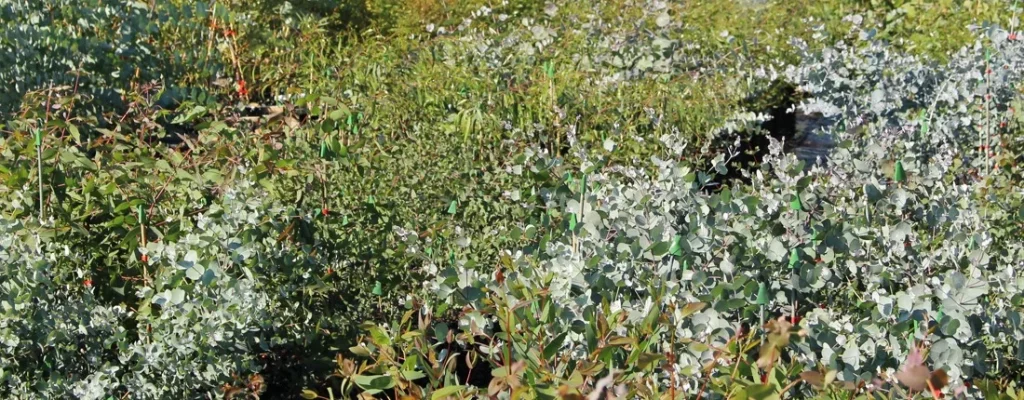
As dahlias and potatoes spring to mind, you are thinking ‘is it something I can eat?’ The answer is an emphatic ‘no!’
Pronunciation: lig-no-tuber The term “lignotuber” was coined in 1924 by Australian botanist Leslie R. Kerr.
Any plant botanists and scientists reading this will probably cringe, but I have simplified the technobabble for ease of digestion.
The Eucalyptus lignotuber is a woody swelling, which can be seen at the root crown; the part of the tree where the trunk or stem meets the root system, usually at soil level. This is a really busy part of the tree. The anatomy of trunks and roots is quite different and serious vascular changes take place at the crown. Its a bit like a major motorway intersection, but with lots of side roads. In the case of the tree, you have raw food manufactured in the leaves being sent down to the roots for storage and conversely water and refined nutrients being brought up from the roots to grow more leaves, branches and lay down woody fiber in the trunk.
This ‘body’, full of dormant vegetative buds, is a tree survival strategy, assisting regeneration after a crisis event, such as a fire, a hard winter or excessive grazing by an animal with a strong constitution and no taste buds! The lignotuber is activated by the removal or death of the top part of the plant, whereupon it produces a mass of vigorous new shoots, which grow up to form the new tree.
Gardeners and foresters can take advantage of this; we can control the height of a Eucalyptus, turn it into a multi-stemmed tree or take a crop of fire-wood. We can cut down a mature Eucalypt to within a few centimeters of the lignotuber and grow the tree back up again. Furthermore, the Eucalyptus lignotuber is an advantage in our variable and difficult UK climate with lots of weather. The top part of the Eucalyptus may well be killed off in an exceptionally harsh winter, but the lignotuber is likely to survive and once pruned down, the tree will regenerate in the following May.
The lignotuber develops out of the cotyledonary material (seed leaves) of a seedling, shortly after germination. It begins as a swelling or pair of bumps in the young tree and develops into something that looks like a woody doughnut at the base of the tree. The lignotuber contains a great deal of stored starchy material and masses of vegetative buds, which lie dormant until called for duty. The stored carbohydrates provide food for the re-growing tree until such time that it can establish a new food factory of photosynthesising leaves .
Other tree species have lignotubers, but not all Eucalyptus have them. Lignotubers on UK Eucalyptus tend not to be very large. I’ve only seen them up to a couple of feet in diameter on very mature trees. Australian-dwelling Eucalypts can have massive lignotubers. Eucalyptus marginata (Jarrah), Eucalyptus brevifolia (Snappy Gum) and Eucalyptus ficifolia (Scarlet Gum) have been recorded with lignotubers of ten feet (3 meters) wide and three feet (one meter) deep.
Many Banksia species and several Oak species including the cork oak Quercus suber. A Chinese Camphor Tree planted in the late 1600s in Cape Town, South Africa has been recorded at 2m tall and 9m in diameter.
In 1977 a lignotuber of a Coastal Redwood (Sequoia sempervirens) casually drifted into Big Lagoon 30 miles north of Eureka, California. It was a ginormous 12.5m (41 feet) in diameter, 6m tall (20ft) and weighing in at 476 tonnes….you could carve that one into a house!

Hilary Collins, Head Gumnut, November 2017
Read more about Ligno-tubers and plant survival here:- https://en.wikipedia.org/wiki/Lignotuber http://learnline.cdu.edu.au/units/env207/ecology/individual.html https://www.britannica.com/science/scrubland#ref589105 https://link.springer.com/chapter/10.1007/978-4-431-68416-9_10
Tel: 01905 888 098
Monday-Friday, 9.00am-4.00pm
Grafton Nursery,
Worcestershire
(Visits by appointment)


We’re here to help you choose your Eucalyptus
We’ll also email you with expert seasonal advice for
your Eucalyptus & exclusive offers. No spam – just Eucalyptus.
You can opt out at any time. Click here to see our privacy policy in full.